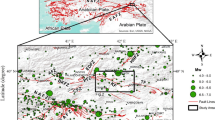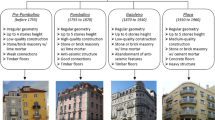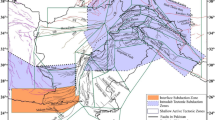Abstract
Within the framework of PERPETUATE project for the case study in Slovenia, the 150 year old Kolizej Palace in Ljubljana was set. The building was for a long time neglected and severely deteriorated due to ageing and moisture problems. Despite the overall opinion among conservators upon its preservation, it was set to be demolished. Prior it’s demolishing in 2011 extensive on-site investigation was carried out, which provided valuable data regarding the influence of deteriorated masonry on the seismic response of the building. Experimental tests proved almost completely saturated moisture conditions in the ground level of the building, while all the stories above were in almost dry condition. The results of tests on masonry revealed that moisture content and state of deterioration affected both strength and stiffness properties of built masonry in large extend. Regardless adopted modelling strategies the vulnerability assessment of the Kolizej Palace has proved that the building in its latest condition was far behind the current code requirements in respect to both static and seismic actions.
















Similar content being viewed by others
References
Amde AM, Martin JV, Colville J (2004) The effects of moisture on compressive strength and modulus of brick masonry. In: 13th International Brick and Block Masonry Conference Amsterdam, pp 4–7
Bergant M, Janežič I (1995) Report on investigation, experimental tests and load bearing structure analysis of Kolizej in Ljubljana with static safety and stability evaluation and preposition for structural retrofitting, DN 15260111/95 (in Slovenian) Ljubljana
Binda L, Anzani A (1996) Report of the Dahlem workshop on saving our arhitectural heritage: the conservation of historic stone structures. Wiley, Berlin
Binda L, De Vekey RC (2003) PRO 26: International RILEM workshop on on site control and evaluation of masonry structures and materials, vol 26. RILEM publications
Bosiljkov V, Maierhofer C, Koepp C, Wöstmann J (2010) Assessment of structure through non-destructive tests (NDT) and minor destructive tests (MDT) investigation: case study of the Church at Carthusian Monastery at Žiče (SLOVENIA). Int J Archit Herit 4(1):1–15. doi:10.1080/15583050902731031
Bosiljkov V, Žarnić R, Čepon F, Kržan M (2008) Static evaluation and analysis of seismic resistance of Kolizej Palace in Ljubljana (in Slovenian). University of Ljubljana, Faculty of Geodetic and Civil Engineering, Ljubljana
Bosiljkov VZ, Totoev YZ, Nichols JM (2005) Shear modulus and stiffness of brickwork masonry: an experimental perspective. Struct Eng Mech 20(1):21–44
Boynton RS, Gutschick KE (1964) Bond of Mortar to Masonry Units. National Lime Association, Washington
Churchill WM (1976) Frost attack on brickwork—three descriptive case histories. In: Fourth International Brick-Masonry Conference, Bruges
Corradi M, Borri A, Vignoli A (2003) Experimental study on the determination of strength of masonry walls. Constr Build Mater 17(5):325–337. doi:10.1016/s0950-0618(03)00007-2
Davison JI (1975) Durability studies on bricks used in the Atlantic Provinces. J Can Ceram Soc 44:7
Davison JI (1982) Effect of air content on durability of cement-live mortars. Durability of building materials. Elsevier Scientific Publishing Co., Amsterdam
EN 1996-1-1: 2005 (2005) Eurocode 6: design of masonry structures - Part 1–1: general rules for reinforced and unreinforced masonry structures. CEN, Brussels, Belgium
EN 1998-1: 2004 (2004) Eurocode 8: design of structures for earthquake resistance - Part 1: general rules, seismic actions and rules for buildings. CEN, Brussels, Belgium
EN 1998-3: 2005 (2005) Eurocode 8: design of structures for earthquake resistance - Part 3: assessment and retrofitting of buildings. CEN, Brussels
Fajfar P (2000) A nonlinear analysis method for performance-based seismic design. Earthq Spectra 16(3):573–592
Grimm CT (1985) Durability of brick masonry: a review of the literature. In: Grogan JC, Conway JT (eds) Masonry: research, application, and problems. ASTM STP 871. American Society for Testing and Materials, Philadelphia, p 33. doi:10.1520/STP34557S
Ingham JP (2005) Predicting the frost resistance of building stone. Q J Eng Geol Hydrogeol 38(4):387–399. doi:10.1144/1470-9236/04-068
Lagomarsino S, Modaressi H, Pitilakis K, Bosjlikov V, Calderini C, D’Ayala D, Benouar D, Cattari S (2010) PERPETUATE Project: the proposal of a performance-based approach to earthquake protection of cultural heritage, Adv Mater Res 133–134:1119–1124. doi:10.4028/www.scientific.net/AMR.133-134.1119
Lagomarsino S, Penna A, Galasco A, Cattari S (2013) TREMURI program: an equivalent frame model for the nonlinear seismic analysis of masonry buildings. Eng Struct 56:1787–1799. doi:10.1016/j.engstruct.2013.08.002
Llewellyn HM, Butterworth B (1964) Laboratory test and the durability of bricks-Part III: some conventional laboratory freezing tests. In: Transactions of the British Ceramic Society,vol 11. Stoke-on-Trent, England, pp 629–637
Lourenço P, Hees R, Fernandes F, Lubelli B (2014) Characterization and Damage of Brick Masonry. In: Costa A, Guedes JM, Varum H (eds) Structural rehabilitation of old buildings, vol 2. Building pathology and rehabilitation. Springer, Berlin Heidelberg, pp 109–130. doi:10.1007/978-3-642-39686-1_4
Lutman M, Weiss P (2004) Analytical evaluation of safety of Kolizej in Ljubljana on the basis of in-situ investigation of load bearing walls and seismic analysis (in Slovenian). ZAG, Ljubljana
McBurney JW, Johnson PV (1956) Durability of deaired brick. J Am Ceram Soc 39(5):159–168. doi:10.1111/j.1151-2916.1956.tb15638.x
NTC08 (2008) D.M. 14 gennaio 2008–Norme tecniche per le costruzioni (in Italian). Ministero delle Infrastrutture
Ritchie T (1972) Freeze-Thaw action on Brick. J Can Ceram Soc 41:6
Ritchie T (1976) Moisture degradation of masonry walls. National Research Council Canada, Ottawa
Ritchie T, Plewes WG (1955) Design of unit masonry for weather resistance. J R Archit Inst Can 32:7
Roca P, Molins C, Marí A (2005) Strength capacity of masonry wall structures by the equivalent frame method. J Struct Eng 131(10):1601–1610. doi:10.1061/(ASCE)0733-9445(2005)131:10(1601)
S.T.A. Data (2009) 3muri, General description, Version: 4
Sheppard P (1985) In situ test of the shear strength and deformability of an 18th century stone-and-brick masonry wall. In: 7th international brick-masonry conference, Melbourne, Australia, pp 149–160
SIST EN 771-1: 2004/A1:2005 (2005) Specification for masonry units— Part 1: clay masonry units (in Slovenian). Slovenski institut za standardizacijo, Ljubljana
Stőckl S, Beckhaus D, Fritsche T (1998) Influence of test method on the results of deformation measurements on uniaxially loaded mortar specimens. Mason Int 12(1):7
Tomaževič M (1987a) Dynamic modelling of masonry buildings: storey mechanism model as a simple alternative. Earthq Eng Struct Dyn 15(6):731–749. doi:10.1002/eqe.4290150606
Tomaževič M (1987b) Masonry buildings in seismic regions (in Slovenian). Slovenian). Faculty of Arhitecture, Civil Engineering and Geodesy, Ljubljana
Tomaževič M (1999) Earthquake-resistant design of masonry buildings. Imperial College Press, London
Turnšek V, Čačovič F (1971) Some experimental results on the strength of brick masonry walls. In: Proceedings of the 2nd International Brick Masonry Conference, Stoke-on-Trent, pp 149–156
Uranjek M, Bosiljkov V, Žarnić R, Bokan-Bosiljkov V (2012) In situ tests and seismic assessment of a stone-masonry building. Mater Struct 45(6):861–879. doi:10.1617/s11527-011-9804-z
Zupančič P (2011) Report on microtremor mesurements in Kolizej palace (in Slovenian). MOP, ARSO, Ljubljana
Acknowledgments
The results were achieved through the project PERPETUATE (www.perpetuate.eu), funded by the European Commission in the \(7\, \mathrm{th}\) Framework Programme (FP7/2007-2013), under Grant agreement no 244229 and by the Ministry of Science and Technology of the Republic of Slovenia. The authors acknowledge the help of Franci Čepon and Gašper Bregar with test executions as well as to Polona Zupančič from ARSO, Slovenia for the evaluation of micro-tremor tests.
Author information
Authors and Affiliations
Corresponding author
Rights and permissions
About this article
Cite this article
Kržan, M., Gostič, S. & Bosiljkov, V. Application of different in-situ testing techniques and vulnerability assessment of Kolizej palace in Ljubljana. Bull Earthquake Eng 13, 389–410 (2015). https://doi.org/10.1007/s10518-014-9639-4
Received:
Accepted:
Published:
Issue Date:
DOI: https://doi.org/10.1007/s10518-014-9639-4




